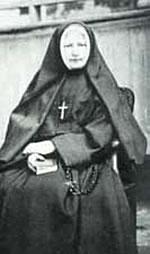Foundress
Venerable Marie Anne Blondin
 Mother Mary Anne
Mother Mary AnneFoundress
In 1850, the Institute of the Sisters of Saint Ann was canonically established in Vaudreuil, Quebec. The Foundress, Marie Esther Sureau Blondin, took the religious name of Soeur Marie Anne (Marie Anne being the Francophone spelling, favoured in the East and Mary Ann being the spelling used in the English-speaking West) of the Sisters of Saint Ann.
Esther was born in Terrebonne, Quebec, on April 18, 1809. She grew up on her parents’ farm, and was involved with the many chores of farming life. The cost of attending school at that time was more than most could afford, even with the sponsorship of religious orders and the parish schools. It was not until the age of 20 that Esther began lessons in reading and writing, under the direction of the Sisters of the Congregation of Notre Dame. She entered the Novitiate, but was forced to leave because of poor health.
 Mother Mary Ann
Mother Mary AnnBust overlooking St. Ann’s entrance
In May, 1833, Esther began teaching in a parish school in Vaudreuil, Quebec, to try to help the children of the area who, like herself, would otherwise have had little opportunity for formal education and literacy. The community founded in 1850 proceeded to develop from six women, initially, to 45 members in 1857. The Sisters faced difficulties in their relations with the chaplain, and Mother Mary Ann was instructed by the Bishop to step down as Superior of the Convent. In spite of obstacles, the women continued on their path of religious observance and community work, dedicating themselves to the education of the poor and the needy, and Saint Ann, patron saint of teachers, acted as their inspiration. In 1856, Mother Mary Ann wrote, “My daughters, let us be teachers worthy of our models the good Saint Ann instructing her Virgin Daughter, Mary full of grace!”
In 1857, Bishop Modeste Demers, Bishop of the Diocese of Victoria between 1847 and 1871, went on an extended journey in search of an order of teaching Sisters to establish a mission in Victoria. The Sisters of St. Ann had been considering taking on such a role since 1851; as a young order, they were not already involved with setting up schools in other parts of the world and readily accepted Bishop Demers’ invitation to come to Vancouver Island. It is said that every single member of the Sisters of Saint Ann willingly volunteered to make the journey and endure the hardships that would surely be in store for them in the Vancouver Island Colony, but only four Sisters and one lay woman were chosen. They arrived at their destination in 1858.
Reverend Modeste Demers
In 1860, the Sisters of St. Ann moved its headquarters to Lachine, on the banks of the St. Lawrence River. Mother Mary Ann, although distanced from her Sisters in the west, continued to think of them and sent letters of support when a member of the community made the trip West.
The following excerpt is from a letter dated July 16, 1876, addressed by “Sister Mary Ann” to her “Reverend and much-beloved Sisters”, in Victoria.
It is quite probable that this will be the last time my unsteady hand fills pages destined for you; and I would like to be able to set down on paper my heartfelt sentiments to prove to you that they are as fervent as ever. You would understand how interested I am in the foundation of Victoria.
I saw the birth of the little Community of the Daughters of Saint Anne. I was a witness to its first years. For all the happiness which flooded my soul then, little did I foresee that one day I would see its fortunate members doing good in a far away land. How sweet it is for me, then, to think that you are all working faithfully in the Lord’s vineyard.
 Reverend Modeste Demers
Reverend Modeste Demers
Bishop Demers was clear that the mission in Victoria involved the education of the young people in the area, and the care of the sick. These goals were met by the Sisters who, through training and experience became nurses and teachers, and often acted as both. These ideals were part of the calling of Esther Blondin, the reasons she felt the need to dedicate herself to a religious life. Her quiet, often inconspicuous presence in the Convent was surpassed by her drive to educate the poor and heal the ill. She kept in mind her goals despite the struggles and oppositions her determination entaled.
Mother Mary Ann was considered such an exemplary figure, that she is currently undergoing the process required for canonization, so that she may obtain sainthood within the Catholic Church. The steps in this process span years. Mother Marie Anne Blondin was declared “Venerable”, sacred by reason of her religious life and heroic virtues, on May 14, 1991. On June 28, 1999, Pope John Paul II signed the declaration approving the “Beatification”, the blessedness, of Venerable Marie Anne Blondin and on April 29, 2001, she was declared Blessed.
The Four Founding Sisters
 Sister Mary Angele
Sister Mary Angele Sister Mary Lumena
Sister Mary Lumena
 Sister Mary Conception
Sister Mary Conception Sister Mary of the Sacred Heart
Sister Mary of the Sacred Heart
Sister Mary of the Sacred Heart, Sister Marie Angele, Sister Mary Lumena, Sister Mary Conception and a lay woman, who later became Sister Mary des Sept Douleurs, set off April 14th, 1858. They left Canada for the West, an area not yet included as part of the country. The journey to Victoria involved a boat from Montreal, a train from New York, a trip on the S.S. Philadelphia to connect to their rail crossing of the Isthmus of Panama, a steamer to San Francisco, another sea voyage as far as Portland, further travel north and the final passage into Victoria aboard the S.S. Seabird.
The women arrived on June 5, 1858. The Hudson’s Bay Company fort and wilderness they were expecting, from the description of Bishop Demers, was not what they found.
The women were shown to the log cabin that was to be their home and school, on a piece of land which remains as part of the grounds of St. Ann’s Academy today. Mrs. Reed, a local woman, came with water, coal and wood, and the Sisters prepared for their first night, hanging their aprons in the windows in lieu of curtains. The school opened on Monday, June 7, and twelve children were registered.
Early Sisters
 Mother Mary Providence McTucker
Mother Mary Providence McTucker
The early Sisters told those they met on their journey to Victoria that they were going to Vancouver Island in search of souls. Their intentions were to establish a school as a Christian mission. When it became clear that Victoria was a larger, more established centre than they had expected, they sent to Lachine for assistance. In 1859, Sister Mary Bon Secours arrived with her talents in the area of music.
There was also a need to find a qualified, English speaking Sister, to teach the Anglophone children of the Hudson’s Bay Company employees. Sister Mary Providence McTucker, a young woman of 22 from Sligo, Ireland, filled this role. She became a leader in the Sisters’ community, and, as Provincial Superior from 1859 to 1881, guided St. Ann’s through religious, business and academic concerns.
There is a long list of Sisters who made the voyage from Quebec to Victoria to participate in the early years of the Academy. Many of them missed their eastern home, and were afraid of the new lives they would lead in the log cabin and View Street schools. They are not anonymous, yet their roles as part of a community made their contributions, as well as their mistakes and difficulties, a collective effort.
